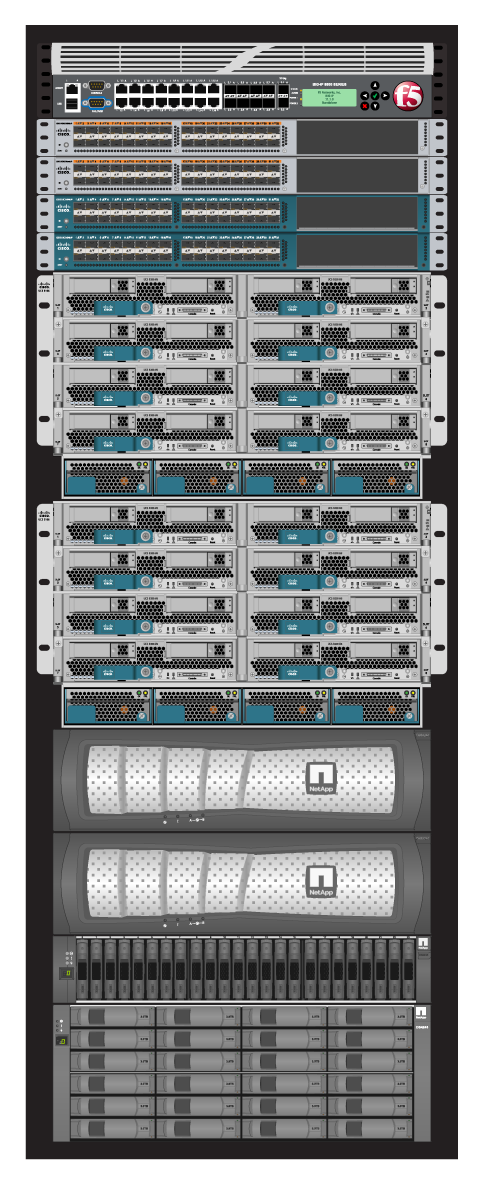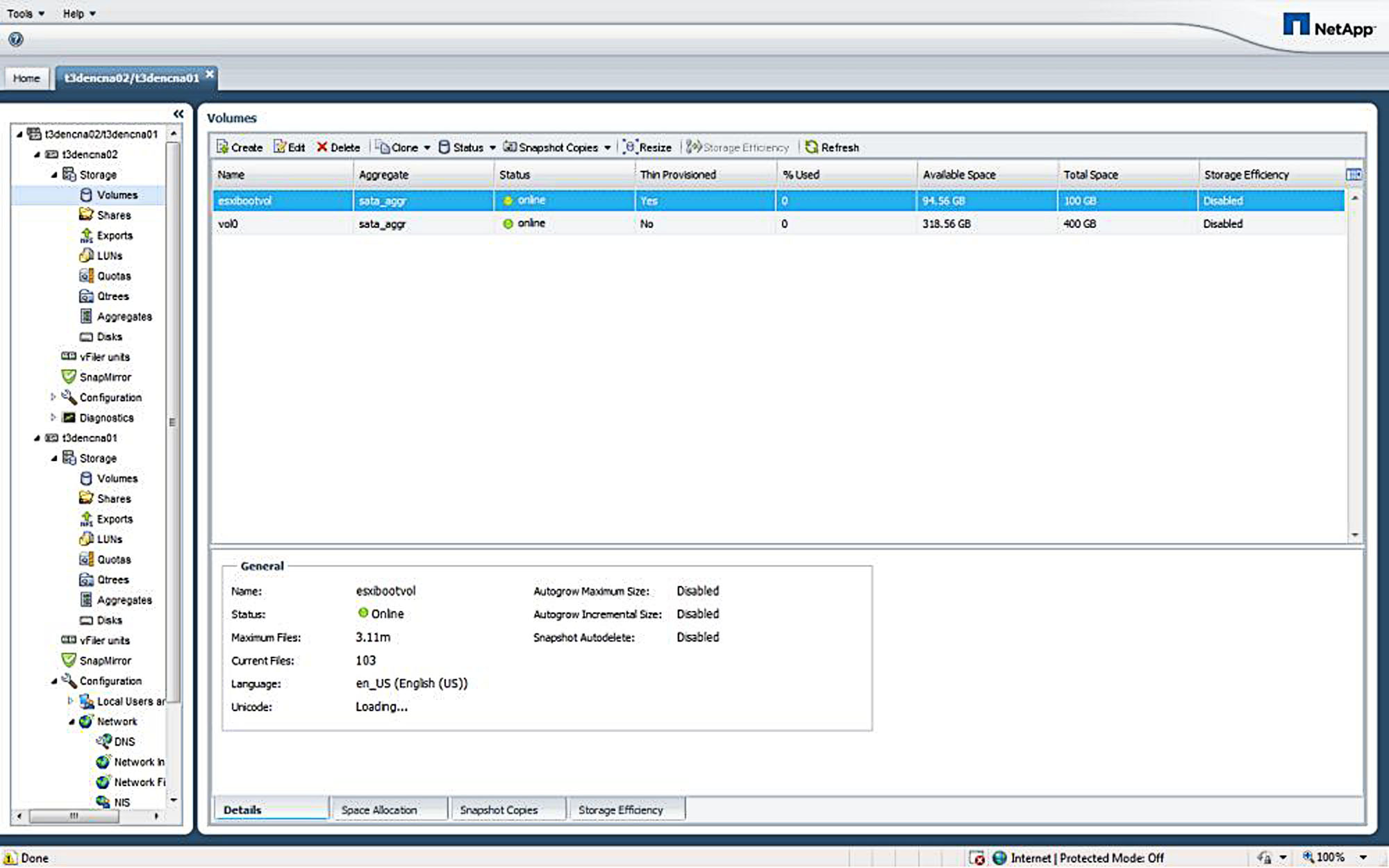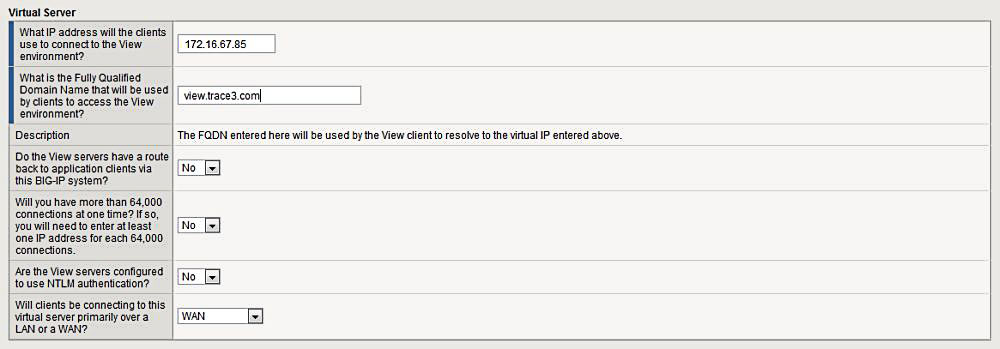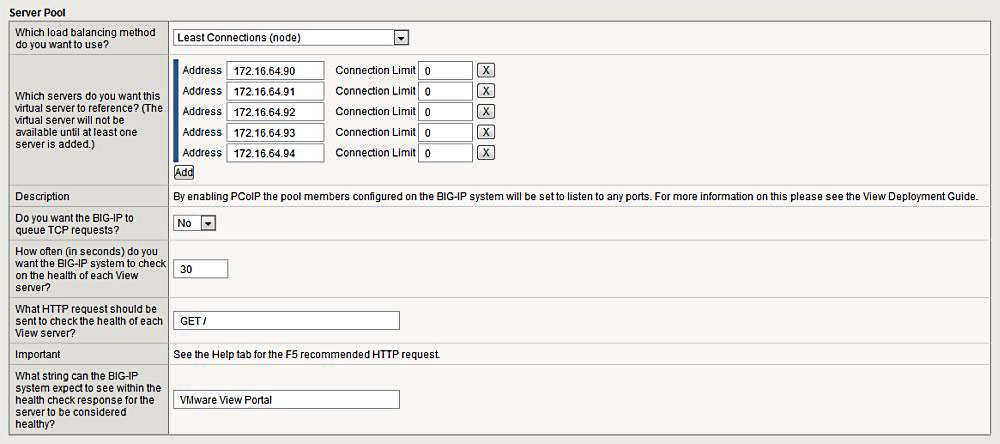Enable a Scalable and Secure VMware View Deployment
NetApp and Cisco have collaborated to provide a validated data center architecture built on the FlexPod data center design. This solution accelerates the overall deployment of virtualized Tier 1 applications, enables rapid data center transformation, and accelerates the deployment of new, mission-critical applications such as VMware View. Thus equipped with the flexibility to customize or modify the computing, storage, or switch components in the architecture, enterprise customers now have a fully validated means to dramatically reduce the design and deployment phases of their application environments.
As a complement to the FlexPod validated architecture, F5 BIG-IP technologies can enhance application performance, ensure application availability, and provide the secure access and remote user authorization necessary for deployment of a virtualized Tier 1 application environment. Deploying VMware View 5.0 on a FlexPod architecture with an F5 Application Delivery Controller (ADC) can extend and enhance the value of FlexPods in a virtual desktop environment. Detailed deployment guidance, which is available through the partnership between F5 and Trace3, supports all aspects of configuration, including that required for the storage, computing, ADC, and application deployments.
Trace3 is a NetApp Star partner and F5 Platinum partner that helps organizations overcome obstacles by partnering with them to develop a strategic approach to meeting business requirements through IT innovation. Trace3 accomplishes its goals through an XARCH approach, providing a strategic roadmap for IT across three practice areas-data center, user computing, and cloud strategies. Through these practices and disciplines, Trace3 provides a customized roadmap encompassing XARCH Solutions, which allow clients to optimize existing investments while increasing the utilization of human capital and equipment. Trace3 solution sets include products, consulting, training, and resource management in a variety of discipline areas, namely storage, networking, virtualization, security, data protection, applications, and project management. Expertise in all of the relevant components of the enhanced FlexPod architecture enables Trace3 to add strong value to any large enterprise deployment of a turnkey FlexPod solution.
One major challenge to large-scale adoption of VMware View in the enterprise has been the ability to effectively scale the infrastructure components necessary to meet the performance characteristics of a virtual desktop deployment. When designing an overall solution, enterprise architects must accommodate unexpected spikes in performance demand. To accelerate performance and improve the overall user experience of virtual desktops, NetApp and F5 Networks provide critical infrastructure components that enable a virtual desktop environment to scale while maintaining a superior user experience. F5 ADCs improve responsiveness by offloading CPU-intensive processes such as managing SSL traffic, pooling connections to back-end servers, and allowing for adaptive compression of traffic to increase overall performance by up to 60 percent.
A similar improvement in performance may be achieved using NetApp Flash Cache storage acceleration technology. An overall solution that incorporates both F5 and NetApp technologies enables a virtual desktop infrastructure (VDI) deployment that can scale more efficiently. From a storage perspective, this means substantially fewer spinning disks in the overall infrastructure.
NetApp has pioneered storage efficiency technology to enable enterprises to realize higher levels of performance with less provisioned physical storage. Embedded features such as deduplication, thin provisioning, compression, and Flash Cache acceleration can provide dramatically improved performance while, at the same time, reducing the storage footprint as well as power and cooling costs.
BIG-IP products provide similar efficiencies at the hypervisor and application level. The BIG-IP platform is central to increasing virtual server density by offloading CPU intensive process from the server. Features such as adaptive compression, SSL offload, and connection pooling can increase server density by up to 60 percent, again reducing the footprint of the deployment. As a result, enterprises can more effectively deploy Tier 1, mission-critical applications in a virtualized environment that complements the validated NetApp data center architecture.
With an increasingly mobile and distributed workforce, enterprises and service providers need a way to securely manage access for remote users working with web-based applications. BIG-IP Access Policy Manager (APM) provides a unified access and authentication platform for both remote users and those authorized in the data center. The SSL VPN remote access security provided by BIG-IP APM offers the highest performance available in the market today and scales to over 100,000 users on a single device. BIG-IP APM recognizes user location and securely authenticates local or remote access for users requiring secure access to applications. Using BIG-IP APM in place of the View security server in a VMware View deployment enables access and authentication for up to 100,000 users.
NetApp SnapMirror provides asynchronous replication to a secondary NetApp storage controller to maintain a reliable and efficient disaster recovery environment. To optimize the performance of the WAN link between sites and improve the overall efficiency of replication, source-based deduplication and compression can be initiated on the NetApp device before the replication takes place. Where latency or packet loss is an issue, a BIG-IP WAN Optimization Module (WOM) can optimize, prioritize, and accelerate the replication traffic, reducing overall WAN bandwidth requirements.

In deployments of virtual desktop software like VMware View, the essential NetApp value proposition includes the ability to rapidly deploy hundreds or thousands of virtual desktops with individual customizations and minimal impact on server resources. Using NetApp FlexClone technology, enterprises can rapidly provision thousands of desktop images with individual customizations through a simple click of the mouse. Tightly integrated into VMware vSphere, FlexClone rapidly provisions tens of thousands of desktop images in minutes with zero increase in overall storage utilization.
An additional challenge to deploying large-scale infrastructures is integrating each component into the infrastructure. NetApp provides certified partners with detailed FlexPod guides that rapidly reduce the time needed to deploy this validated data center solution. FlexPod technology not only reduces the time to deploy the physical infrastructure components, but also dramatically reduces the time typically required to test and validate each component. With a validated architecture for storage, computing, and Layer 2 networking, enterprises can reduce the overall time needed to test multiple components to ensure interoperability. Certified NetApp partners such as Trace3 are armed with the appropriate tools to size and adequately configure a FlexPod so that it can scale to meet application and user workloads.
Eliminating complexity and speeding deployment are crucial to the ultimate success of a VMware View solution. FlexPod deployment guides are complemented by F5 deployment guides, which together enable deployment of an Application Ready Solution across platforms.
F5 iApps Templates further reduce deployment times. These menu driven, customizable, reusable, and application-specific templates enable administrators to deploy the necessary elements of an ADC solution without requiring expertise in the associated BIG-IP product modules. iApps Templates are reusable, and many existing iApps for specific needs are available for sharing via the F5 DevCentral development community. Administrators can also code and configure their own iApps for deployment of non-standard applications with F5 ADCs. The standard iApps Template was used to configure all the necessary components for the VMware View 5.0 environment.
The validation was designed to proceed in two phases and demonstrate both local user connections and remote access to a virtual desktop environment. The validated NetApp environment used both a storage area network (SAN) as well as network-attached storage (NAS) to provision storage to the Cisco Unified Computing System (UCS) blade server components. Each controller in the NetApp architecture had two 8 GB Fibre Channel ports as well as two 10 GB Ethernet ports connected to the Cisco UCS. For purposes of installing and booting the VMware ESX hosts, storage was provisioned via Fibre Channel. The guest storage and virtual desktop were provisioned from NetApp over NFS. NetApp FlexClones were used to rapidly deploy VMware View virtual desktops.
To thoroughly validate the value of the combined BIG-IP APM/FlexPod solution, a 10 GB capacity solution was deployed with the FlexPod. Phase One of the deployment used a BIG-IP 8900 appliance licensed for BIG-IP Local Traffic Manager (LTM) as well as BIG-IP APM. Both 10 GB interfaces were configured on the device and plugged into the Nexus 5548 switches.

One NetApp controller was configured with a 10,000 RPM SAS disk shelf and the other was provisioned with 1 TB of SATA storage. The ESX hosts were configured to boot from SAN storage using the SATA storage, and the SAS storage was provisioned to support the VMware View desktop environment. Configurations included five View Connection Servers to which the BIG-IP device would direct user traffic. All users would access their virtual desktops via the virtual server on the BIG-IP device as opposed to accessing the five View Connection Servers directly. Two ESXi servers were configured to support the virtual desktop pools.

To simulate a real-world deployment of a virtual desktop infrastructure (VDI), configuration included two separate virtual desktop pools, one to allow access via PCoIP and the other to allow connections via Microsoft Remote Desktop Protocol (RDP). The purpose was to demonstrate local user connections to a virtual desktop environment via both protocols. The second phase of testing validated remote user access to the VDI environment via BIG-IP APM. In both scenarios, BIG-IP LTM provided basic traffic management and load balancing of the View Connection Servers.
The BIG-IP 8900 device was deployed with software version 11.1 hot fix (HF) 1 to support iApps functionality. The NetApp 3240 controllers were installed with ONTAP 8.1 7-mode RC3. VMware ESX 5.0 was the hypervisor used during all phases of the testing, and vSphere was used to manage the ESX hosts and provision NetApp FlexClones.
| QTY | Item | Description | Notes |
|---|---|---|---|
| 2 | NetApp FAS3240AE | NetApp FAS Controllers | Controllers Redundant NetApp FAS controllers for FlexPod architecture |
| 1 | DS2246 | SAS 600 GB, 10 K RPM, 6 GB disk shelves | High performance disk storage |
| 1 | DS4243 | SATA 1 TB, 7200 RPM disk shelves | Denser, lower-performance disk storage |
| 2 | Flash Cache Module | Flash Cache 512 GB PCIe Module | Flash Cache acceleration technology |
| 2 | Cisco UCS 5108 | Cisco UCS Chassis | 4 B200 blades in chassis used for the purpose of this test |
| 4 | Cisco B200 Blades | Cisco Blade Servers | Blades used only in top chassis |
| 2 | Cisco Nexus 5548UP | Nexus Unified Switch | Block and NFS connectivity |
| Cisco UCS 6248UP | Fabric Interconnects | Network fabric and compute environment management system | |
| 1 | F5 BIG-IP 8900 | BIG-IP LTM and BIG-IP APM | Application delivery and access and authentication |
Figure 4: Physical hardware components in the FlexPod and F5 lab setup
To demonstrate the NetApp rapid provisioning of virtual desktops, the test utilized the NetApp plug-in to VMware vSphere to provision 40 separate desktops spread across two separate desktop pools. As FlexClone does not utilize the CPU of the ESX servers, the process of rapidly cloning multiple virtual desktops took only minutes to complete, customize, and boot in ESX.
Each desktop pool was configured to allow separate groups of user logins that would simulate a multi-departmental VDI deployment. For example, users view1 through view6 were configured to have access to pool1 and access their desktops via PCoIP. Users viewRDP1 through viewRDP6 were configured to access desktops in pool2 via RDP.
For this purpose, there were 2 VLANS configured-an internal-facing VLAN for network connections to the back-end View Connection Servers and an external-facing VLAN for client connections. Two self-IP addresses were configured and assigned to each VLAN. While this demonstration environment used the default certificates, for a full production deployment of VMware View on FlexPod, procurement of an SSL certificate from a certificate authority is recommended.
The testing plans encompassed two phases. In the first, only BIG-IP LTM would be deployed via an iApp template to show a hybrid PCoIP and RDP local desktop environment. The second phase combined a scenario where a remote user would receive authentication via BIG-IP APM and access a desktop via single sign-on (SSO) authentication. The additional components specific to BIG-IP APM were configured and generated using the iApp template.
Licenses for both BIG-IP LTM and BIG-IP APM were obtained. Once basic licensing and network/VLAN configuration was completed, all additional configuration was performed using the appropriate iApp template.




Two NetApp 3240 controllers were configured with separate disk technologies on each host. The first controller was equipped with a single shelf of 600 GB, 10,000 RPM, SAS disk storage with 22 disks in a single aggregate. The second controller was attached to the 1 TB SATA storage, which was used to provision SAN storage for the ESX servers. The higher performance SAS storage was provisioned for the virtual desktops via NFS to ensure adequate performance for access to remote desktops. To further accelerate performance, Flash Cache was enabled on the second controller. A simple command-line interface (CLI) command on the NetApp controller activated and deactivated Flash Cache.
Two ESX servers were set up and provisioned a total of five View Connection Servers on the first (.86) server. The virtual desktops were provisioned with NetApp FlexClone technology as opposed to the VMware Linked Clones feature, since FlexClone utilized the back-end array, is integrated into vSphere, and does not require VMware composer to deploy linked clones. A total of 40 virtual desktops were provisioned across two pools. One pool allowed access to desktops via native PCoIP, a UDP a feature introduced in View 4.5. The second pool was configured to allow access only via Microsoft RDP.
| View Connections |
|
| ESX Servers |
|
| BIG-LTM IP Addresses |
|
| Virtual Server FqDN | view.trace3.com |
Figure 8: IP address information of the VMware View environment
Once the testing environment was set up and configured, testing proceeded in two phases to demonstrate access to the VDI environment using both local and remote user scenarios. The first phase focused on PCoIP and RDP access.
The first phase involved user access via PCoIP and RDP to demonstrate the contrasts between the two methods. Each of the five View Connection Servers was configured to point to the IP address of the BIG-IP LTM virtual server (as opposed to pointing individually to each of the five View Connection Servers). Having all users point to a single virtual server IP address enabled the five View Connection Servers to appear as a single installation accessed via a single virtual IP (VIP) address. In this way a View 5.0 installation can effectively scale beyond the 2,000-connection limit of an individual View Connection Server to make a five server, 10,000 user deployment appear like a single server deployment.
An additional benefit of this configuration is performance. The BIG-IP device offloads CPU-intensive processes from the servers, increasing performance and improving virtual server density. This process was validated with user connections made via PCoIP to BIG-IP LTM and then connected directly to the View Connection Server. Connecting via the virtual server, as opposed to connecting directly to an individual View Connection Server, demonstrated approximately a 25 percent performance improvement.
The second set of tests involved accessing the RDP virtual desktop pool. Although the Remote Desktop Protocol takes more time to connect to a virtual desktop than PCoIP does, it is a more commonly used protocol in data centers. In testing, users successfully accessed the virtual desktop via the same BIG-IP LTM virtual server IP address. Testing additionally demonstrated nearly a 30 percent reduction in the time required to access the desktop via BIG-IP LTM compared to direct connection to the View Connection Server.
The second phase of the testing demonstrated the capabilities of remote access via BIG-IP APM. With version 11.x and above, a simple reconfiguration of the iApp was all that was required for the iApp to support the BIG-IP APM deployment. The iApp reconfiguration involved the following sections:
- Configuration and authentication to the domain. In this case, authentication was configured for the ‘View’ domain.
- A lease pool of IP addresses configured for remote users. In this case, a range of 192.168.1.x addresses was created in the iApp.
- A separate, virtual server IP address. This virtual server address used the previously configured virtual server IP address of BIG-IP LTM as its sole pool member.
Once the iApp was reconfigured, the additional BIG-IP APM objects were configured In the BIG-IP LTM and BIG-IP APM sections of the BIG-IP GUI, and testing proceeded to demonstrate successful remote access via BIG-IP APM.
FlexPod data center architectures have generated substantial momentum in the marketplace and via mutual F5 and NetApp sales channels. Trace3, a leading NetApp and F5 partner, has collaborated with both to rapidly deploy a VMware View 5.0 environment using the storage efficiency of NetApp technologies and the application acceleration of the F5 ADC.
Based on the results of that testing, organizations choosing the validated FlexPod architecture can be assured that their virtualization initiatives can be deployed on a scalable platform with traffic management, access, and authorization provided by the leading ADC in the market. Using the BIG-IP 8900 device to enhance and extend the FlexPod data center design enables a full Application Ready Solution that can be simply and rapidly deployed-whether for VMware View, Tier 1 applications, or large-scale transformation of the data center infrastructure. The result is a virtualized infrastructure that provides the enterprise with greater scalability at dramatically reduced footprint, power, and cooling costs.